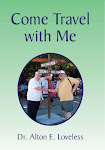
In His Steps
In my travels I have had many opportunities to meet great men. One such person was Garrett Shelton, a professor at the University of Virginia-Wise and pastor of the First Baptist church in Big Stone Gap.
He wrote What Would Jesus Do which paralleled the WWJD excitement a few years ago.
However, Garrett’s additional claim to fame is he is the great-grandson of the infamous Charles Sheldon who wrote In His Steps.
In 1889 Charles moved west to become pastor of the fledgling Central Congregational Church in Topeka, Kansas. He announced he would preach "a Christ for the common people. A Christ who belongs to the rich and poor, the ignorant and learned, the old and young, the good and the bad . . . a Christ who bids us all recognize the Brotherhood of the race, who bids throw open this room to all."
The most successful series, In His Steps, concerned the inhabitants of a town who pledged themselves to live for a year as Jesus would live. It was first published serially in 1896 and in book form in 1897. The unifying theme of these sermons was based on posing the question, "what would Jesus do?" when facing moral decisions.
In 1900 Dr. Sheldon, proposed that the local newspaper should be operated as Christ would operate them. The owner allowed Dr. Sheldon to serve as "editor" for a week in March. The "Sheldon Edition" sent circulation from 12,000 daily to 387,000. The Capital's pressroom was swamped, and other printing facilities, one in New York and one in Chicago, each printed 120,000. The Daily Capital printed the other 120,000 papers by using an extra work force.
The Advance, a Congregational weekly magazine in Chicago, purchased the story for $75.00 and published it serially in thirty-one installments beginning November 5, 1896. Sheldon offered the manuscript to three book publishers who turned it down. Finally J. C. Kilner, manager of the Advance Publishing Company, which had never before published any fiction, decided to bring out In His Steps in book form. The first printing of a few thousand copies consisted of cloth and paper bound volumes, the former priced at one dollar; the paperback, twenty-five cents. Two years later a ten cent paperback edition was published. By 1900 Advance had published nearly 600,000 copies in five editions.
Because "In His Steps" was in the public domain virtually from the beginning, companies could print copies of it without the author's permission, not owing Sheldon a cent. More than a century later, some 50 million copies had been published, making it second in sales among religious books behind only the Bible. Sheldon did not receive any royalty for his work which would have left his family well to do. But this would have run contrary to the desire he intended for man in his book.
Dr. Eric Goldman of the Saturday Literary Review singled out In His Steps as one of eight books which have changed America
Charles Monroe Sheldon was born in 1857 and grew up in the Dakota Territory, where his parents homesteaded in a log cabin he helped build. His father, Rev. Steward Shelton, was the Territory's first home missionary superintendent, founding 100 churches in 10 years. Young Sheldon "hunted with the Dakotas, fished with them, slept with them on the open prairie, and learned some of their language."
Sheldon graduated from Andover in the class of 1879.
One of the remarks I recall by my friend Garrett Sheldon was, "By the time he left home to go to school, he had heard the entire Bible read aloud five times. Now think of that!"
Besides the Bible this is one book everybody should read.
“A good name is rather to be chosen than great riches, and loving favour rather than silver and gold.” -- Proverbs 22:1







